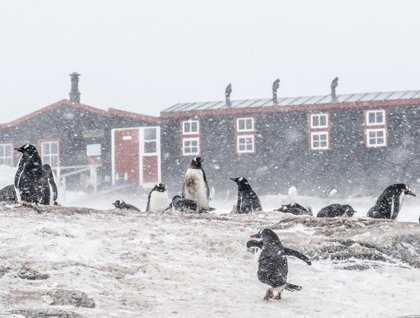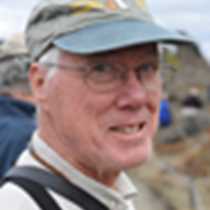It was an Antarctic Day! After our days of bright sunshine, brilliant vistas, and sunburned noses, we were lucky enough to see and experience another side of Antarctica. A short run from the site of last night's festivities at the U.S. Antarctic Research Program's Palmer Station brought us to Port Lockroy, a well-protected harbor tucked into Wienke Island. Since its discovery by the French Antarctic explorer Jean-Baptiste Charcot in 1903, it has been used by Antarctic explorers to repair their ships and by whalers to process their catch. In 1944, the British established Base A here as part of a wartime effort under the name of Operation Tabarin (the code name Tabarin taken from a bawdy bar in Paris.) The purpose is not altogether clear. Following the war it became a science base used largely for atmospheric studies. Base A was abandoned in 1962 and left to fall into ruins, but then was taken over by the U.K. Antarctic Heritage Trust and turned into an Antarctic museum and the almost-farthest-south gift shop. Proceeds from the gift shop support the preservation of historic huts in this sector of the Antarctic. We did our best to advance that cause!
The National Geographic Explorer was docked in the shorefast ice of Port Lockroy - that is, sea ice left over from last winter and still contiguous with the land. One of our activities of the morning involved stepping off the ship for a stroll over the sea ice, leaning into the howling wind. We rotated over to Jougla Point, where Antarctic shags and gentoo penguins ignored the blowing snow to carry on with their breeding activities. This included penguins stealing stones from their neighbor’s nests while their own nests were being similarly pilfered and the shags carrying nesting material to add to the nests and impress their mates. The third stop of the circuit was Bransfield House, the restored Base A, where the collection of period artifacts shows us what life was like for men stationed in the Antarctic in the mid-twentieth century. We hunkered down for the last Zodiac ride back to our ship. Were we put off by the weather? Not at all! To the last person, we were giddy with excitement and grateful for the experience. We had taken what Antarctica could throw at us and we emerged victorious, with stories to share with friends and family back home.
And so the bow of our ship was pointed toward the north. We passed through Dallmann Bay, between Anvers and Liege Islands. Snow was gathering on the surface of the ocean, a phenomenon that can occur only when the temperature of the seawater is below the freezing point of fresh water (32° F, 0° C or, thank you Andrew Clarke, 273° K). It formed a final, lasting image of Antarctica as we enjoyed a fine Thanksgiving dinner and then headed out into the Drake Passage toward our destination of Ushuaia.









